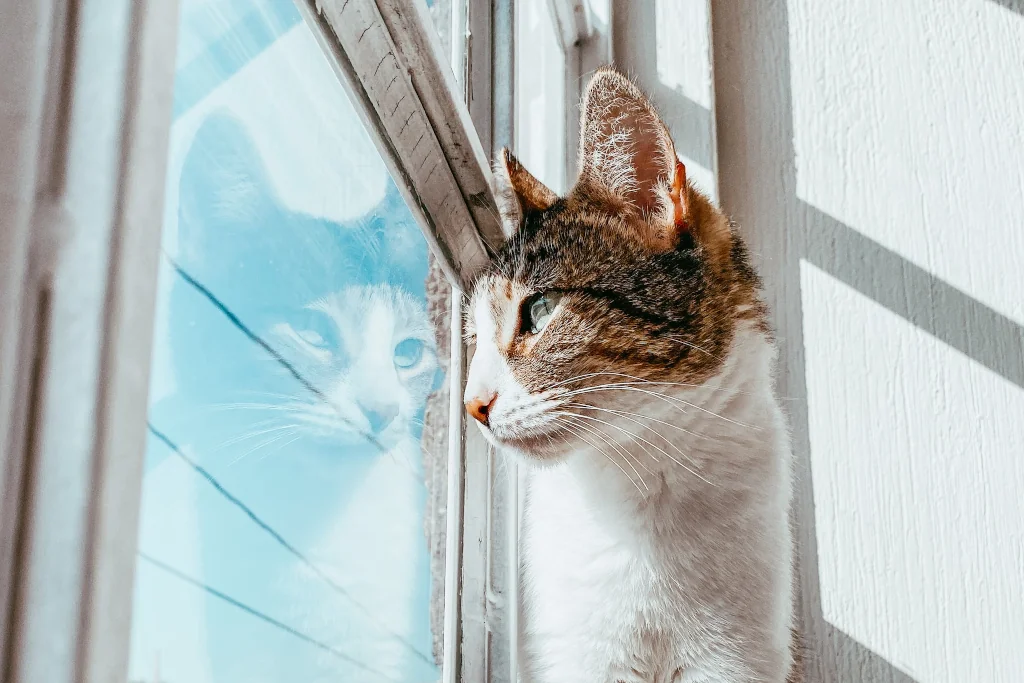Disclosure: We may earn a commission from helpful, relevant links in our content. No cost to you. See our privacy policy.
Leaving town but worried about your whiskered friend? It’s a common concern for cat owners—how long can Fluffy manage on her own and how to ensure she stays safe and comfortable?
Whether you’re planning an overdue vacation or an impromptu business trip, your feline friend’s well-being is undoubtedly a top priority. Let’s navigate this together, drawing on expert insights to guide your furry companion through your absence.

Leaving Your Cat Alone: What’s the Ideal Time Frame?
While cats are known for their independence, they still require daily care and attention.
Generally, it’s safe to leave a healthy, adult cat alone for up to 24 hours. Anything beyond that, especially for several days, requires careful planning.
Kittens, elderly cats, and cats with health issues should never be left alone for this long. If your absence is unavoidable, it’s crucial to ensure their needs are met and their environment is secure and stimulating.
Preparing Your Cat for Your Absence
Before you pack your suitcase, there are a few steps to take to prepare your cat for your absence:
- Gradually acclimatize them to your absence by leaving them alone for increasing periods of time, making sure they have all they need for comfort and safety.
- Consider an automatic feeder, such as the Healthy Pet Simply Feed Automatic Feeder from PetSafe. It ensures your cat receives fresh food at the correct times. Check it out here to ease your worries about your pet’s nutrition while you’re away.
- A self-cleaning litter box is also a good investment to maintain hygiene. These are a bit more expensive than your typical litter box, but they can save a lot of headaches. These self-cleaning litter boxes reduce odor, keep your cat’s space tidy, and you don’t have to scoop for weeks.
- Leave some of your worn clothing items around the house. Your scent can provide comfort and help minimize anxiety.
- Interactive toys and puzzle feeders are great for stimulating your cat’s brain and keeping them busy. The “Petstages Tower of Tracks” offers hours of fun and is loved by cats everywhere. For mealtime, the “Catit Senses 2.0 Food Tree” is a puzzle feeder that turns eating into a game, reducing the risk of overeating and boredom. Curious? You can check the tower here and the feeder here.
Remember, each cat is unique, and what works for one might not work for another. It’s all about understanding your feline friend’s needs and making them feel secure and loved, even in your absence.
Setting Up the House: Safety Measures and Supplies
A cat-friendly home setup is critical when planning an extended absence.
Ensure you’ve cat-proofed the house: secure loose wires, lock away harmful substances, and remove small items that could be a choking hazard.
Invest in a gravity-based water and food dispenser to ensure a constant supply of fresh food and water. Consider the AmazonBasics Gravity Pet Food Feeder and Water Dispenser. It’s simple, reliable, and a favorite among cat owners. Click here to check it out.
Equipping your home with a self-cleaning litter box, such as a Litter Robot 4, will keep their toileting area clean and odor-free. While it’s not cheap, it’s also a game-changer. It keeps your cat’s area clean and odor-free, making your return home more pleasant. Sounds good? Find out more about it here.
For a unique touch, consider setting up a bird feeder near a window—this creates ‘cat TV,’ offering your pet hours of harmless bird-watching entertainment. You might be surprised how much your cat appreciates this little addition!
Also, keep the climate in mind. If you live in a region with a hot climate, ensure there’s a cool spot in the house where your cat can retreat, or if it’s cold, ensure there’s warm bedding available.
How Might Your Cat React to Being Alone?
Just like people, cats respond differently to solitude—some enjoy their own company, while others may get lonely or anxious. Monitor your cat’s behavior after short periods of absence to get a sense of their response.
Watch for signs of stress or anxiety post-separation, like excessive grooming, loss of appetite, or unusual aggression. These could indicate that your cat isn’t comfortable being alone for extended periods.
A novel suggestion is to use technology to your advantage. Invest in a pet camera that allows two-way communication. Not only does this let you check in on your feline friend, but it also lets you interact with them, reducing feelings of loneliness or anxiety. The Furbo Dog Camera is a popular choice, and highly recommended.
Remember, understanding your cat’s individual temperament is key in preparing them for your absence and ensuring their comfort and well-being during this time.
Considering a Pet Sitter: Is it Worth It?
Pet sitters can be a boon when you’re away. They offer not just care but also companionship for your cat. But is it worth it? Let me share my experience with my male cat, Smokey.
Smokey, a loving and attention-seeking tabby, once developed a case of the ‘lonely blues’ when I was away for a week. Despite all the preparations, he became noticeably aloof on my return. It was then I decided to hire a pet sitter for the next trip. Smokey’s spirits were much improved, as the sitter provided not just food and clean litter, but also play and cuddle sessions. This made all the difference.
Hiring a professional pet sitter may come at a cost, but the benefits – reduced stress for your cat, regular updates for you, and the comfort of knowing a professional is on hand if emergencies arise – are often worth it.
FAQs
What’s the longest time I can safely leave my cat alone?
The longest time to leave a cat alone safely varies but generally, it’s not recommended to leave a cat alone for more than 24 hours. For longer absences, hiring a pet sitter or arranging daily visits from a trusted person is advisable.
Can I use a pet camera to monitor my cat while I’m away?
A pet camera is an excellent tool for monitoring your cat while you’re away. It can provide valuable insight into your cat’s well-being and allow for interactive features like two-way communication.
Are certain cat breeds more okay with being left alone?
Cat breeds do differ in their tolerance of solitude. Breeds like Russian Blue, British Shorthair, and Maine Coon are known for their independence. However, each cat’s personality plays a significant role, making it vital to understand your cat’s unique needs and behavior.
Should I hire a pet sitter or ask a friend to check in on my cat?
Hiring a professional pet sitter can offer expert care and peace of mind, while friends may offer a more personal touch and familiarity for your cat. It ultimately depends on your cat’s needs, the trustworthiness of the friend, and your budget.
Alex, a passionate animal lover, has experience in training and understanding animal behavior. As a proud pet parent to two dogs and three cats, he founded AnimalReport.net to share insights from animal experts and expand his knowledge of the animal kingdom.




